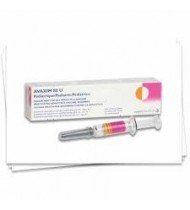Hepatitis A Vaccine
Indications
Hepatitis A Vaccine is indicated for active immunization against disease caused by hepatitis A virus (HAV). Hepatitis A Vaccine is approved for use in persons 12 months of age and older. Primary immunization should be administered at least 2 weeks prior to expected exposure to HAV.
Pharmacology
The hepatitis A virus belongs to the picornavirus family. It is one of several hepatitis viruses that cause systemic disease with pathology in the liver. The incubation period for hepatitis A averages 28 days (range: 15 to 50 days). The course of hepatitis A infection is extremely variable, ranging from asymptomatic infection to icteric hepatitis and death. The presence of antibodies to HAV confers protection against hepatitis A infection. However, the lowest titer needed to confer protection has not been determined.
Dosage
Children and Adolescents: Primary immunization for children and adolescents (12 months through 18 years of age) consists of a single 0.5 mL dose and a 0.5 mL booster dose administered anytime between 6 and 12 months later. The preferred sites for intramuscular injections are the anterolateral aspect of the thigh in young children or the deltoid muscle of the upper arm in older children.
Adults: Primary immunization for adults consists of a single 1 mL dose and a 1 mL booster dose administered anytime between 6 and 12 months later. In adults, the injection should be given in the deltoid region.
Adults: Primary immunization for adults consists of a single 1 mL dose and a 1 mL booster dose administered anytime between 6 and 12 months later. In adults, the injection should be given in the deltoid region.
Administration
Preparation For Administration: Shake well before use. With thorough agitation, Hepatitis A Vaccine is a homogeneous, turbid, white suspension. Do not administer if it appears otherwise. Parenteral drug products should be inspected visually for particulate matter and discoloration prior to administration, whenever solution and container permit. If either of these conditions exists, the vaccine should not be administered.
For the prefilled syringes, attach a sterile needle and administer intramuscularly.
For the vials, use a sterile needle and sterile syringe to withdraw the vaccine dose and administer intramuscularly. Changing needles between drawing vaccine from a vial and injecting it into a recipient is not necessary unless the needle has been damaged or contaminated. Use a separate sterile needle and syringe for each individual.
Hepatitis A Vaccine should be administered by intramuscular injection only. Hepatitis A Vaccine should not be administered in the gluteal region; such injections may result in suboptimal response. Do not administer this product intravenously, intradermally, or subcutaneously.
For the prefilled syringes, attach a sterile needle and administer intramuscularly.
For the vials, use a sterile needle and sterile syringe to withdraw the vaccine dose and administer intramuscularly. Changing needles between drawing vaccine from a vial and injecting it into a recipient is not necessary unless the needle has been damaged or contaminated. Use a separate sterile needle and syringe for each individual.
Hepatitis A Vaccine should be administered by intramuscular injection only. Hepatitis A Vaccine should not be administered in the gluteal region; such injections may result in suboptimal response. Do not administer this product intravenously, intradermally, or subcutaneously.
Interaction
Reduced response to vaccination when used concurrently with immunosuppressants such as corticosteroids or antineoplastics.
Contraindications
Hypersensitivity. Vaccines prepared in egg cultures are contraindicated in patients with hypersensitivity reactions to egg. Severe immunodeficiency. Malignant disease being treated with chemotherapy or radiotherapy and for at least 6 mth after stopping treatment. Patients with compromised immune system such as those on high-dose systemic corticosteroids, immunosuppressants or HIV positive.
Side Effects
Transient soreness, erythema, induration at inj site. Fever, malaise,
Pregnancy & Lactation
Pregnancy Category C. Either studies in animals have revealed adverse effects on the foetus (teratogenic or embryocidal or other) and there are no controlled studies in women or studies in women and animals are not available. Drugs should be given only if the potential benefit justifies the potential risk to the foetus.
Nursing Mothers: It is not known whether Hepatitis A Vaccine is excreted in human milk. Because many drugs are excreted in human milk, caution should be exercised when Hepatitis A Vaccine is administered to a nursing woman.
Nursing Mothers: It is not known whether Hepatitis A Vaccine is excreted in human milk. Because many drugs are excreted in human milk, caution should be exercised when Hepatitis A Vaccine is administered to a nursing woman.
Precautions & Warnings
Alcohol or disinfectant used for cleaning the skin prior to inj should be allowed to evaporate completely before vaccination to prevent vaccine inactivation.
Use in Special Populations
Pediatric Use: The safety and effectiveness of Hepatitis A Vaccine, doses of 360 EL.U. or 720 EL.U., have been evaluated in more than 22,000 subjects 1 year to 18 years of age. The safety and effectiveness of Hepatitis A Vaccine have not been established in subjects younger than 12 months of age.
Geriatric Use: Clinical studies of Hepatitis A Vaccine did not include sufficient numbers of subjects 65 years of age and older to determine whether they respond differently from younger subjects. Other reported clinical experience has not identified differences in overall safety between these subjects and younger adult subjects.
Hepatic Impairment: Subjects with chronic liver disease had a lower antibody response to Hepatitis A Vaccine than healthy subjects
Geriatric Use: Clinical studies of Hepatitis A Vaccine did not include sufficient numbers of subjects 65 years of age and older to determine whether they respond differently from younger subjects. Other reported clinical experience has not identified differences in overall safety between these subjects and younger adult subjects.
Hepatic Impairment: Subjects with chronic liver disease had a lower antibody response to Hepatitis A Vaccine than healthy subjects
Therapeutic Class
Vaccines, Anti-sera & Immunoglobulin
Storage Conditions
Store refrigerated between 2° to 8° C . Do not freeze. Discard if the vaccine has been frozen. Do not dilute to administer.
Showing 1 to 1 of 1 (1 Pages)

